In October, I had the privilege of attending Singapore Design Week, representing Design Matters as we co-hosted the Emerging Technologies segment of the Design Futures Forum 2024. Our segment was held in the historic Old Parliament House of Singapore, providing a symbolic setting for exploring the future of design. For many of the local speakers, sitting in the very chair once occupied by Singapore’s former Prime Minister, Lee Kuan Yew, was a surreal experience!

Inside of the Old Parliament House in Singapore
This vibrant event brought together leading minds in design and technology from across the globe, particularly from Asia, and provided invaluable insights into sustainability, inclusivity, and the intersection of nature and technology in design. Being in Singapore, a city that harmonizes its tropical greenery with cutting-edge architecture, proving how design can shape and support urban life in remarkable ways.
In this piece, I’m going to highlight what stood out the most for me during my stay in Singapore.
Sustainability at its Core
Singapore has become a global leader in sustainable urban design, and its efforts were clearly reflected in the talks of the Design Futures Forum 2024. One standout presentation was given by Zac Toh, a local designer focused on integrating nature with city life. He shared his work designing bird nests that blend seamlessly into Singapore’s urban landscape and flora, creating habitats for native bird species amidst the city’s skyline. To me, this approach really demonstrated Singapore’s commitment to creating a livable, ecologically sensitive city that respects and preserves its natural surroundings.
Another inspiring speaker, Boonserm Premthada from Thailand, shared his work from Bangkok Project Studio, where he designs spaces that celebrate the relationship between humanity and nature. Premthada, who grew up in a Bangkok slum and now designs sanctuaries for elephants and humans alike, offered a unique perspective on how structures can coexist with and respect the natural world. His work—like a museum for both elephants and humans—embodies the harmonious relationship he envisions between people and the environment. Hearing from voices like his was particularly impactful, as it emphasized the diversity of design perspectives across Asia and the profound commitment to sustainability.

The Power and Potential of AI in Design
Artificial Intelligence remains a hot topic, with designers from around the world sharing new approaches to AI-powered design tools. Our Emerging Technologies segment saw insightful presentations from Megan Bednarczyk, Senior Design Manager at Duolingo, who showed how her team integrated AI into Duolingo Max, their premium language-learning experience. Megan’s talk truly showed the ways in which AI can provide personalized learning experiences, enhancing accessibility and adaptability within educational design.
Tobias Ahlin from GitHub was another highlight, as he shared his predictions for AI and tech-driven futures, sparking reflection among attendees. He discussed the potential for AI to redefine not only design processes but also how we experience products on a personal and societal level. These sessions left no doubt that AI is a priority for designers in Singapore and beyond, as they navigate both its possibilities and ethical considerations.
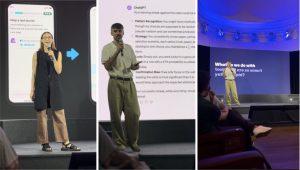
Singapore’s Digitalization and Commitment to Citizen-Centric Design
Two standout speakers in our Emerging Tech segment, Samantha Lee and Ben Bowes from Open Government Products, brought focus on Singapore’s remarkable level of digitalization and security. Their talk covered how the government integrates design into its digital services, reflecting a commitment to creating user-friendly, secure experiences for citizens and residents alike. Together, they painted a compelling picture of how Singapore’s government leverages design not just as a tool but as an ethos, demonstrating Singapore’s dedication to ensuring accessible and efficient public services—a model that many nations might aspire to.
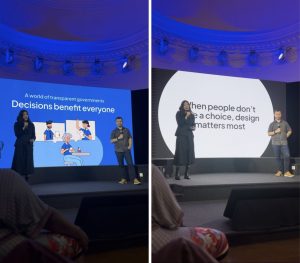
Redefining Inclusivity in Design
Inclusivity and the future of care were central themes in the Care segment of Design Futures Forum 2024. Claudia Poh, founder of Weareble, shared her journey in designing adaptive clothing for people with disabilities and reduced mobility. Her recent trip to the Paralympic Games in Paris allowed her to connect directly with athletes, gaining invaluable feedback for creating garments that prioritize functionality, dignity, and comfort. Her work is reshaping how we think about inclusivity in fashion and how design can serve everyone.

A Symbiosis of Nature and Architecture
Singapore itself was an embodiment of the design principles we discussed at the event. The city’s skyline seamlessly blends lush greenery with architectural marvels like the Jewel at Changi Airport, Marina Bay Sands, and the conservatories at Gardens by the Bay. These structures represent Singapore’s commitment to a “city in a garden” ethos (also the slogan of the city), where concrete and greenery coexist harmoniously. Walking through the city, I was struck by its cleanliness and design-centered approach to urban living—a quality that makes it one of the most livable cities I’ve visited.

Gardens by the Bay
Beyond the modern buildings, Singapore also maintains its historic architecture. In areas like Chinatown, you’ll find eclectic colored heritage houses; this architectural style, called Peranakan, incorporates elements of both Chinese and Portuguese architectural styles. I thought this balance between past and present architecture adds depth to the city, reflecting Singapore’s rich multicultural heritage and commitment to preserving its history amid rapid development.

Perankan Architecture
Cultural Fusion and Safety
Singapore’s cultural diversity was apparent in every experience, from the temples dotting the cityscape to the language spoken by locals. One moment you’re admiring a Buddhist temple, and the next, just steps away, you’re walking past a Hindu temple. I felt like multiple religions and cultures could coexist peacefully, something that is quite rare to see in the main European cities. This unique cultural blend even extends to language, as I discovered when I heard people speak Singlish, an English-based creole that’s both charmingly efficient and distinctly Singaporean. As a person with a background in linguistics, this place was heaven for my ears!
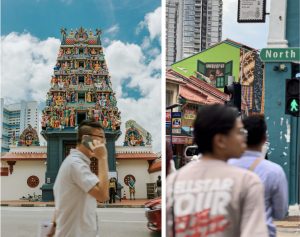
Hindu temple (pexels) and Haji Lane in Singapore (Arab neighborhood)
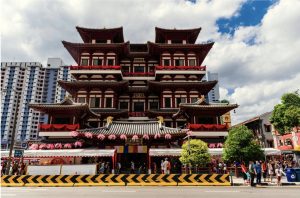
Buddha Tooth Temple in Chinatown in Singapore (pexels)
Moreover, Singapore felt incredibly safe, which I deeply appreciated, especially as a female traveler. Even at night, wandering through the city’s alleys felt safe. No harassing, no catcalling. Another thing that caught my attention was the high standard of respect and trust in public spaces. I noticed there are quite a few restrictions and regulations, some being stricter than others; consuming food and drinks is prohibited on public transport (that probably explains why public transport is so clean), feeding pigeons is fined, durians are not allowed (I’m guessing because of the smell), and chewing gum is banned to maintain the city’s cleanliness. I also discovered that Singapore also has the death penalty for crimes like murder, terrorism, and drug trafficking.
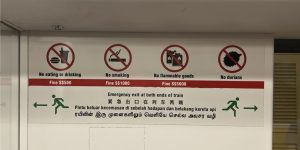

Photos I have captured
A Refreshing Approach to Communication
Collaborating with the organizing team of Singapore Design Week highlighted another notable aspect: the direct and efficient communication style. Unlike other high-context cultures, such as Japan, where meaning can be deeply nuanced and implied, the Singaporean team was refreshingly straightforward. I found this approach to be a positive surprise, allowing us to work seamlessly and achieve clarity quickly. It truly represents Singapore’s unique position as a fast-paced, multicultural hub that bridges East and West, with a communication style that’s adaptable to a diverse array of backgrounds.

The team and I tried the stingray (and other delicacies like the Hainanese chicken)
Wrapping up
Reflecting on my experience, Singapore has undoubtedly become one of my top destinations for both work and inspiration. The city’s commitment to sustainability, safety, and cultural inclusivity left a lasting impression, as did the designers and innovators the team and I had the opportunity to meet – such as Wendy Chua, Design-anthropologist and Programme Leader at Lasalle College of the Arts, Eason Yang, Designer, Speaker, Educator, who founded Not Entirely Dead and is a Board Member of AIGA New York, and Carl Constantin Press, Director at dmg events, who runs FIND Design Fair Asia, Asia’s largest event for furniture, interiors and design.
This journey, albeit hot and humid, was rich with ideas and connections that I’ll carry forward. I look forward to any opportunity to return to Singapore—whether for leisure or work—as it continues to inspire and lead in the world of design.







